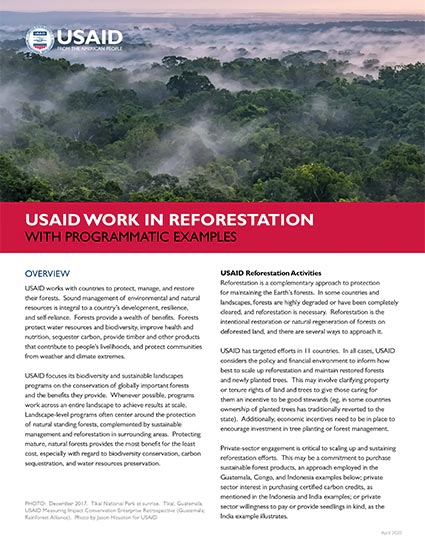- What We Do
- Agriculture and Food Security
- Democracy, Human Rights and Governance
- Economic Growth and Trade
- Education
- Environment and Global Climate Change
- Environmental and Natural Resource Management Framework
- Global Climate Change
- Conserving Biodiversity and Forests
- Sustainable Urbanization for Global Progress and Security
- Securing Land Tenure and Property Rights for Stability and Prosperity
- Sustainable Land Management
- Environmental Procedures Hub
- Knowledge Management for Environment and Natural Resources
- Tropical Forest and Coral Reef Conservation Act
- Environmental Policy Roadmap
- Gender Equality and Women's Empowerment
- Global Health
- Humanitarian Assistance
- Transformation at USAID
- Water and Sanitation
- Working in Crises and Conflict
- U.S. Global Development Lab
Speeches Shim
![]() (786k) USAID Work in Reforestation
(786k) USAID Work in Reforestation
USAID works with countries to protect, manage, and restore their forests. Sound management of environmental and natural resources is integral to a country’s development, resilience, and self-reliance.
Forests provide a wealth of benefits. Forests protect water resources and biodiversity, improve health and nutrition, sequester carbon, provide timber and other products that contribute to people’s livelihoods, and protect communities from weather and climate extremes.
USAID focuses its biodiversity and sustainable landscapes programs on the conservation of globally important forests and the benefits they provide. Whenever possible, programs work across an entire landscape to achieve results at scale. Landscape-level programs often center around the protection of natural standing forests, complemented by sustainable management and reforestation in surrounding areas. Protecting mature, natural forests provides the most benefit for the least cost, especially with regard to biodiversity conservation, carbon sequestration, and water resources preservation.
USAID Reforestation Activities
Reforestation is a complementary approach to protection for maintaining the Earth’s forests. In some countries and landscapes, forests are highly degraded or have been completely cleared, and reforestation is necessary. Reforestation is the intentional restoration or natural regeneration of forests on deforested land, and there are several ways to approach it.
USAID has targeted efforts in 11 countries. In all cases, USAID considers the policy and financial environment to inform how best to scale up reforestation and maintain restored forests and newly planted trees. This may involve clarifying property or tenure rights of land and trees to give those caring for them an incentive to be good stewards (eg, in some countries ownership of planted trees has traditionally reverted to the state). Additionally, economic incentives need to be in place to encourage investment in tree planting or forest management.
Private-sector engagement is critical to scaling up and sustaining reforestation efforts. This may be a commitment to purchase sustainable forest products, an approach employed in the Guatemala, Congo, and Indonesia examples below; private sector interest in purchasing certified carbon credits, as mentioned in the Indonesia and India examples; or private sector willingness to pay or provide seedlings in kind, as the India example illustrates.
USAID Reforestation Approaches
Natural regeneration of forests can be facilitated by protecting and better managing areas to allow naturally occuring young trees to reach maturity. Compared to agroforests or plantations, natural forests provide greater ecological benefits such as carbon sequestration, biodiversity conservation, and watershed resilience.
Active forest restoration involves reconstructing environmental conditions such as water table levels, fire regimes, or soil fertility, removing invasive species, and planting native tree species to enable forests to recover. This approach can be more expensive than natural regeneration, but is sometimes necessary in more degraded lands.
Agroforestry can be used to restore deforested and degraded land to agricultural systems that include trees for production, resilience, or conservation purposes. Agroforests often generate more income for landowners in the short term, but they provide fewer ecological benefits than natural forests.
Plantations can be established on deforested and degraded land to create productive areas, which may range from monocultures of a single tree species to a mix of tree species. These species may not be native to the region. Like agroforests, plantations often generate more income for landowners in the short term. However, plantations generally store less carbon and generate fewer ecological benefits than natural forests.


Comment
Make a general inquiry or suggest an improvement.